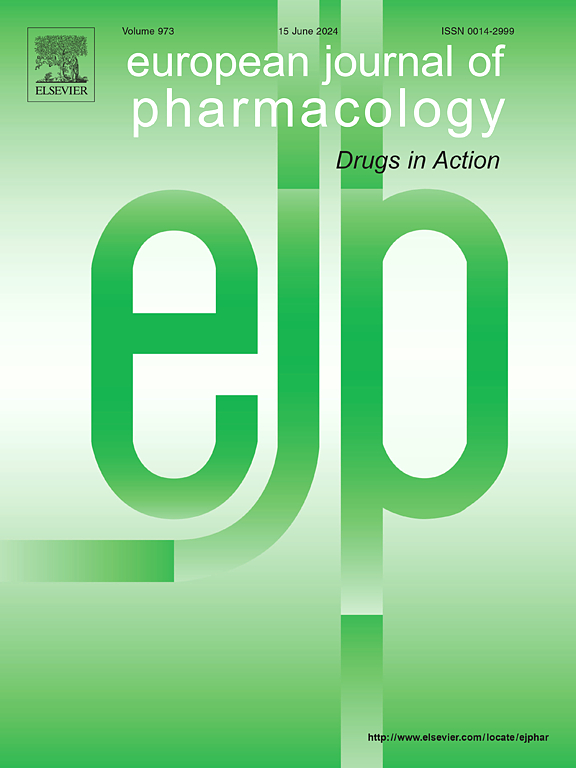Pro-histaminergic drug restores balance, promotes microgliogenesis and modulates neuroinflammation after vestibular injury
IF 4.2
3区 医学
Q1 PHARMACOLOGY & PHARMACY
引用次数: 0
Abstract
Vestibular compensation is a neurobiological process that allows the recovery of impaired vestibular functions after unilateral vestibular damage. Among the post-injury plasticity mechanisms expressed in the vestibular nuclei (VN) that promote the restoration of balance function, neurogliogenesis and excitability changes appear to be in the forefront. At the central level, the vestibular syndrome expression results from an electrophysiological imbalance between both VN, known to activate the central histaminergic system. In this study, we aimed to investigate the impact of pharmacological modulation of the central histaminergic system on balance function recovery and its underlying post-injury mechanisms in the deafferented VN. For this purpose, we used a histamine analog, betahistine dihydrochloride (BD), which increases histamine synthesis and release in the VN through its histamine H3 autoreceptor antagonistic properties. The effect of BD treatment was tested in 3 animal groups: a UVN BD group subjected to unilateral vestibular neurectomy (UVN) treated orally during 10 days (50 mg/kg/day), a UVN placebo group (control), and a SHAM group. We show for the first time, in a UVN rodent model, the effects of BD on the reduction of the vestibular syndrome and highlight new targets and impact of this drug at the cellular level. Indeed, the results show that treatment with BD significantly attenuates the number of astrocytes and microglia which are key components of neuroinflammation. BD also prioritizes the differentiation of neoformed cells towards a microglia phenotype. These results, which need to be confirmed and further investigated by identifying the histaminergic receptors responsible for this effect, may lead to new therapeutic targets in vestibular pathology.
前组胺能药物恢复平衡,促进小胶质细胞生成,调节前庭损伤后的神经炎症
前庭代偿是一个神经生物学过程,允许单侧前庭损伤后受损的前庭功能恢复。在前庭核(VN)表达的促进平衡功能恢复的损伤后可塑性机制中,神经胶质瘤的发生和兴奋性的改变似乎是最重要的。在中枢水平,前庭综合征的表达是由两个VN之间的电生理失衡引起的,已知这可以激活中枢组胺能系统。在这项研究中,我们的目的是研究中枢组胺系统的药理调节对室性神经损伤后平衡功能恢复的影响及其潜在的损伤后机制。为此,我们使用了一种组胺类似物,盐酸倍他司汀(BD),它通过其组胺H3自身受体的拮抗特性增加组胺在VN中的合成和释放。在3个动物组中测试了BD治疗的效果:单侧前庭神经切除术(UVN)口服治疗10天(50 mg/kg/天)的UVN BD组,UVN安慰剂组(对照)和SHAM组。我们首次在UVN啮齿动物模型中展示了BD对减少前庭综合征的作用,并强调了该药物在细胞水平上的新靶点和影响。事实上,结果表明,用BD治疗显著减少星形胶质细胞和小胶质细胞的数量,这是神经炎症的关键组成部分。BD还优先将新生细胞向小胶质细胞表型分化。这些结果有待证实,并进一步研究确定负责这种作用的组胺能受体,可能会导致前庭病理的新治疗靶点。
本文章由计算机程序翻译,如有差异,请以英文原文为准。
求助全文
约1分钟内获得全文
求助全文
来源期刊
CiteScore
9.00
自引率
0.00%
发文量
572
审稿时长
34 days
期刊介绍:
The European Journal of Pharmacology publishes research papers covering all aspects of experimental pharmacology with focus on the mechanism of action of structurally identified compounds affecting biological systems.
The scope includes:
Behavioural pharmacology
Neuropharmacology and analgesia
Cardiovascular pharmacology
Pulmonary, gastrointestinal and urogenital pharmacology
Endocrine pharmacology
Immunopharmacology and inflammation
Molecular and cellular pharmacology
Regenerative pharmacology
Biologicals and biotherapeutics
Translational pharmacology
Nutriceutical pharmacology.

 求助内容:
求助内容: 应助结果提醒方式:
应助结果提醒方式:


